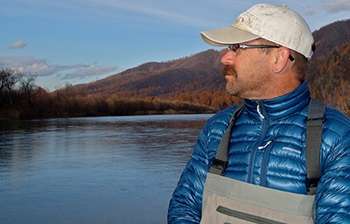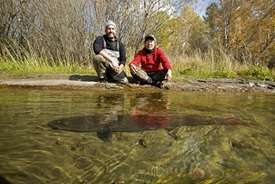Aquatic systems researcher to join international effort to study rivers on large scale

Ball State University's Mark Pyron is joining an international effort to study how large river systems on two continents support life and how climate change could affect those ecosystems.
Pyron, a Ball State biology professor who studies aquatic systems, will participate in a 5-year, $4.2 million grant from the National Science Foundation as one of the co-principal investigators. The project is looking at macrosystems, a larger scale than previous studies, and researchers hope to gain a better understanding of the impact of climate change.
"We will be comparing river ecosystems in North America and Mongolia to test theories about how rivers are linked to their watersheds," Pyron said. "We will also examine how river ecosystem characteristics change with surrounding hydro geomorphology—the underlying geology and shape of the river valley."
Like time travel
Bordered by China and Russia, Mongolia is known for its vast, rugged expanses and its nomadic people.
"Mongolian rivers are considered pristine due to the lack of influence by human impact like dams and non-native fauna, like our U.S. rivers may have looked 200 years ago," Pyron said. "Mongolian landscapes are spectacular, and their rivers are clear enough to observe fish from a boat. Mongolia has one of the strongest warming systems in the North Temperate Zone and could tell us the transformation of our rivers in the future due to climate change."

The project also will examine how Mongolian water systems could change with additional human development and introduction of non-native plant species, he said.
Researchers will sample nine rivers in the U.S. Great Plains, Great Basin and Mountain Steppe, including the Platte, Niobrara, Humboldt, Bear and Snake rivers. In Mongolia, they will investigate rivers within montane steppe ecoregions similar to those in the U.S.
Opportunities for students
Pyron visited Mongolia in 2014 along with several principal investigators to examine potential rivers and collect fish on the Eg River. When he returns to the Central Asian country in 2017, Pyron will lead a group of college students to collaborate with Mongolian scientists and collect data.
"I anticipate our students will be extremely impressed with these trips and with the opportunity to work with excellent U.S. and Mongolian scientists and students," he said.
The principal investigator for the project is James Thorp, a University of Kansas professor of ecology and evolutionary biology and senior scientist with the Kansas Biological Survey. NSF's Macrosystem Biology program in the Division of Environmental Biology is supporting this work. Kansas provided a grant of more than $20,000 for a 2014 workshop that brought together scientists from the U.S., Mongolia and France to develop the ideas for this proposal.
Provided by Ball State University



















